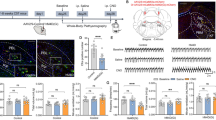Summary
The effect of a spider toxin (JSTX-3)—a specific blocker of glutamate receptors—on the behavior of mice was studied using an intracerebroventricular (i.c.v.) injection technique. At higher doses (more than 12 nmol/brain), JSTX-3 increased motor activities and induced characteristic symptoms. JSTX-3 at a dose of 4.7 nmol/brain which per se did not produce any abnormal behavior, specifically antagonized quisqualate-induced convulsions but not NMDA- or kainate-induced confulsions. These results indicate that JSTX-3 is a selective antagonist of the quisqualate receptors in the mammalian central nervous system.
Similar content being viewed by others
References
Abe T, Kawai N, Miwa A (1983) Effects of a spider toxin on the glutaminergic synapse of lobster muscle. J Physiol (Lond) 339: 243–252
Akaike N, Kawai N, Kiskin NI, Kljuchko EM, Krishtal OA, Tsyndrenko AA (1987) Spider toxin blocks excitatory amino acid responses in isolated hippocampal pyramidal neurons. Neurosci Lett 79: 326–330
Aramaki Y, Yasuhara T, Higashijima T, Yoshioka M, Miwa A, Kawai N, Nakajima T (1986) Chemical characterization of spider toxin, JSTX and NSTX. Proc Jpn Acad 62: 359–362
Chapman AG, Meldrum BS, Nanji N, Watkins JC (1987) Anticonvulsant action and biochemical effects in DBA/2 mice of CPP, a novel N-methyl-D-aspartate antagonist. Eur J Pharmacol 139: 91–96
Collingridge GL, Kehl SJ, McLennan H (1983) The antagonism of amino acid-induced excitations of rat hippocampal CA1 neurons in vitro. J Physiol (Lond) 334: 19–31
Herndon RM, Coyle JT (1977) Selective destruction of neurons by a transmitter agonist. Science 198: 71–72
Kauer JA, Malenka RC, Nicol RA (1988) NMDA application potentiates synaptic transmission in the hippocampus. Nature 334: 250–252
Kawai N, Miwa A, Saito M, Pan-Hou HS, Yoshioka M (1984) Spider toxin (JSTX) on the glutamate synapse. J Physiol (Paris) 79: 228–231
Kawai N, Niwa A, Abe T (1982) Spider venom contains specific receptor blocker of glutaminergic synapses. Brain Res 247: 169–171
Mayer ML, Westbrook GL (1987) The physiology of excitatory amino acids in the vertebrate central nervous system. Prog Neurobiol 28: 197–276
Miwa A, Kawai N, Saito M, Pan-Hou HS, Yoshioka M (1983) Effect of a spider toxin (JSTX) on the excitatory postsynaptic current at neuromuscular synapse of spiny lobster. J Neurophysiol 58: 319–326
Monagham DT, Holets VR, Toy DW, Cotman CW (1983) Anatomical distributions of four pharmacologically distinct3H-L-glutamate binding sites. Nature 306: 176–179
Morris RGM, Anderson E, Lynch GS, Baudry M (1986) Selective impairment of learning, blockade of long-term potentiation by an N-methyl-D-aspartate receptor antagonist, AP5. Nature 319: 774–776
Nadler JV, Evenson DA, Cutbertson GJ (1981) Comparative toxicity of kainic acid, other acidic amino acids toward rat hippocampal neurons. Neuroscience 6: 2505–2517
Peterson DW, Collins JF, Bradford HF (1984) Anticonvulsant action of amino acid antagonist kindled hippocampal seizures. Brain Res 311: 176–180
Piredda S, Gale K (1986) Role of excitatory amino acid transmission in the genesis of seizures elicited from the deep prepiriform cortex. Brain Res 377: 205–210
Saito M, Sahara Y, Miwa A, Shimazaki K, Nakajima T, Kawai N (1989) Effects of a spider toxin (JSTX) on hippocampal CA 1 neurons in vitro. Brain Res 481: 16–24
Sato K, Morimoto K, Okamoto M (1988) Anticonvulsant action of a non-competitive antagonist of NMDA receptors (MK-801) in the kindling model of epilepsy. Brain Res 463: 12–20
Shiells RA, Falk G (1987) Joro spider venom: glutamate agonist and antagonist on the rod retina of the dogfish. Neurosci Lett 77: 221–225
Shinozaki H, Shibuya I (1974) A new potent excitant, quisqualic acid: effects on crayfish neuromuscular junction. Neuropharmacology 13: 665
Slaughter MM, Miller RF (1981) 2-Amino-4-phosphonobutyric acid: a new pharmacological tool for retina research. Science 211: 182–185
Toki T, Yasuhara T, Aramaki Y, Osawa K, Miwa A, Kawai N, Nakajima T (1988) Isolation and chemical characterization of a series of new spider toxins (nephilatoxins) in the venom of Joro spider,Nephila clavata. Biomedical Res 9: 421–428
Watkins JC, Evans RH (1981) Excitatory amino acid transmitters. Annu Rev Pharmacol Toxicol 21: 165–204
Author information
Authors and Affiliations
Rights and permissions
About this article
Cite this article
Himi, T., Saito, H., Kawai, N. et al. Spider toxin (JSTX-3) inhibits the convulsions induced by glutamate agonists. J. Neural Transmission 80, 95–104 (1990). https://doi.org/10.1007/BF01257076
Received:
Accepted:
Issue Date:
DOI: https://doi.org/10.1007/BF01257076




